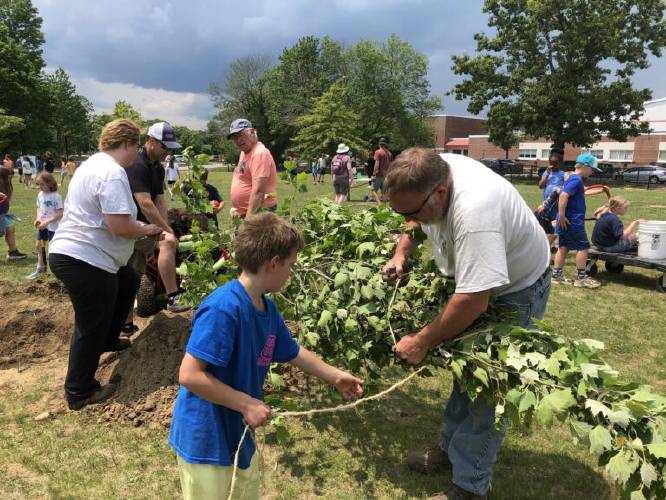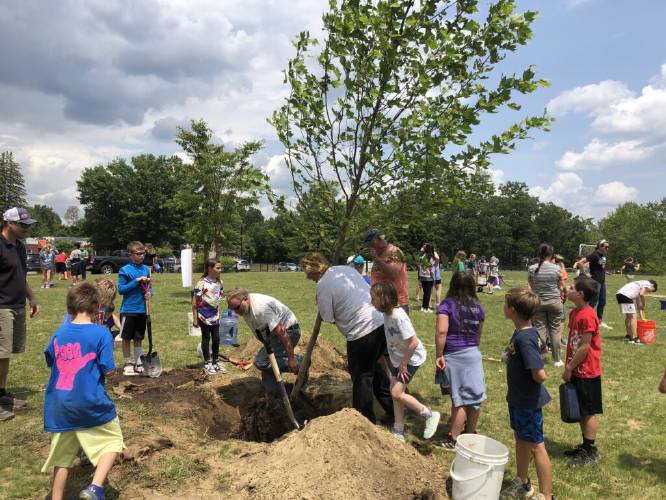Why this program is providing free trees to New Hampshire schools
| Published: 03-07-2024 6:31 PM |
On a sunny day last June, students at Abbot-Downing School in Concord gathered eagerly around a newly dug crater. Ready to fill it was a London plane, a deciduous tree that grows large with spiky, green fruit and can live for several hundred years.
The children examined its extensive root system, picked up shovels to aid in the planting, and helped hoist the tree into the upright position. They watched curiously as the branches and leaves rose to meet the clouds drifting across the sky overhead.
The London plane found its home on this Concord elementary school’s grounds because of the Schoolyard Canopy Enhancement Program, piloted last year by the state’s Division of Forests and Lands. Now in its second year, the program provides schools in need with free trees, while requiring that students be part of the planting and care process.
The effort underscores the importance of trees in schoolyards. Research has shown trees and vegetation in these settings can have significant positive impacts on child development, learning, and their ability to focus.
A 2020 study out of the University of Illinois, which examined 450 public schools in Washington state, found green cover “significantly and positively predicts achievement in sixth-grade students.” The “greener” the schools, the higher the test scores, the study said, even after taking income into account, and trees planted within 250 meters of a school building may boost scores the most.
“Planting trees in and immediately around schoolyards has the potential to be an inexpensive and simple way to boost academic performance,” the researchers wrote.
A.J. Dupere, an urban forester with the state, said his department has worked intermittently with schools over the years – mostly when individual teachers reached out with interest. But last year, they had some available funding from the U.S. Forest Service to cement a more official partnership.
New Hampshire may be the second most forested state in the country, but that doesn’t mean the tree cover is equally distributed. This effort sought to address a very specific gap.
Article continues after...
Yesterday's Most Read Articles
“This program really started because there are several schools in New Hampshire that just don’t have any trees on their playground,” Dupere said. “None. You’d be surprised. You’d think it was a Boston or a Worcester thing, but it’s right here.”
Landscaping is a cost, he acknowledged, and one that’s frequently first to be cut when school departments are looking to save dollars. But for the experts at the Urban and Community Forestry Bureau, “trees are an easy thing for us to do,” Dupere said.
Last year, also working with the University of New Hampshire Cooperative Extension, they partnered with 11 schools across the state – from Manchester and Lebanon, to Somersworth and Bath – planting species such as American larch, black gum, Norway spruce, and plum and apple trees.
Schools selected for the program, which must be located on publicly owned land, receive between three and six trees, and those with the greatest need for tree canopy improvements are given priority consideration.
As part of the student participation requirement, schools in their applications must provide a plan for who will partake in the planting and then take care of the trees after the fact. Dupere said some schools last year created watering schedules for interested students over summer vacation.
“We want the kids involved because we wanted to provide that educational element,” he said. “Getting the kids out, getting them to learn about the trees.”
In Nashua, where many of the city’s schools are surrounded by majority concrete and asphalt, Dupere recalled walking around with students as they decided where they might like to see their trees planted – empowering them to be invested in the process from start to finish.
Some schools have taken advantage of their new trees to create cross-curricular connections. One used their art class to paint rocks and make rings around the trees, while another had students do bark and leaf rubbings while learning about fall foliage.
The deadline to apply for this year’s program is March 25, and all plantings must be completed by June 30. For more information, schools can contact community forester Liz McKinley at elizabeth.c.mckinley@dncr.nh.gov.









 Canterbury honors ‘real heroes’ with updated Military Veterans’ Project
Canterbury honors ‘real heroes’ with updated Military Veterans’ Project Look, up in the sky! It’s… an Airstream trailer?
Look, up in the sky! It’s… an Airstream trailer? Around Concord: Over The Moon Farmstead brings mead, beer, pizza and music to Pittsfield
Around Concord: Over The Moon Farmstead brings mead, beer, pizza and music to Pittsfield Around Concord: The Balshaws bring a rustic revival to the Canterbury Country Store
Around Concord: The Balshaws bring a rustic revival to the Canterbury Country Store
